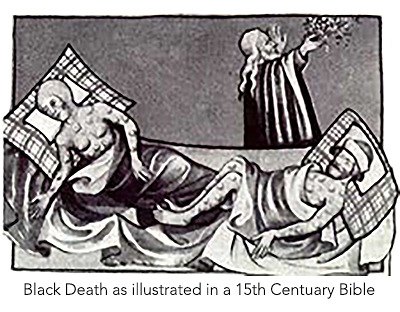
Museum archives: Plagues and Pestilence
The bubonic plague of 1348-1350, known as the Black Death, may have happened in a completely different world from today’s Coronavirus and been due to a bacterium rather than to a virus but it did have some things in common.It almost certainly originated in Asia and travelled via the Mediterranean to Europe and, once in this country, spread with great speed through person to person contact. It could also be claimed that, like Coronavirus, the Black Death was no respecter of rank or status though those in poor circumstances were the most likely to be affected. In all probability the plague reached these shores through black rats as carriers of infected fleas and would then have been carried around England by other fleas and lice on their human ‘hosts’.
In fact, although no accounts of the plague survive in local records, signs of its effects can be deduced. There are clues in records for Wappingthorn, an estate owned by William Bonet. Apart from the home farm William owned 'divers lands in Chyntyng near Seford, Combes, Anyngdon and the town de Sancto Botolfe' [St. Botolphs]. He also held 'a messuage [a house and garden] and 2 carucates of land in Stenyng' [a ‘carucate’ being as much land as a team of oxen would plough in a year] and a further messuage and 240 acres in the parish of Sele or Beeding. He was certainly a wealthy man. But when the plague reached Steyning towards the end of 1348 he was among the first to die followed a few months later by his daughter-in-law Margaret and then his son Nigel.
That, by itself, is rather sparse evidence for the plague. But, in practice, no one in Steyning, a medium-sized market town, would have been insulated from the deaths of maybe 100 to 300 of their friends, family and acquaintances. Perhaps the lack of a direct mention at the time suggests that, in those desperate years, regular manorial accounts were not so meticulously kept.
More concrete evidence for the impact of the plague, however, can be gleaned from seeing how estates fared in the years after the plague had moved on. In March 1350 Wappingthorn had just six men ‘on the payroll’, only one of these being a ‘villein’ owing feudal dues; the others being free men paying rent. A rental of 60 shillings had previously been expected from the estate’s tenants but, as each man paid only 2/6 on average, 24 of them would have been needed to fulfill the full rental obligations. The inference must be that 19 men were no longer around to pay their dues.
A similar picture is painted for the Wiston estate. In an account roll for 1345-6 there were 18 customary tenants – men and women who rendered service to the lord of the manor – plus three thrashers and a smith. By 1357-8 this number had fallen by nine and, across the estate as a whole 40-50% of the customary tenants, who had rendered service before the Black Death struck, had died or had fled elsewhere to avoid their obligations.
We can also deduce that the miller, Roger Wodeman, had died; his mill had become too dilapidated to be used. We find 'Roger of the Mill' again in an earlier document listing his manorial obligations; he was required 'to reap an acre of wheat and to provide half a scythe to mow in Laghmeade and half a wain to carry hay'. Following his death, the lord of the manor would have lost the benefit of those services. 'Half a scythe' - it’s the sort of detail which both intrigues and brings you closer to the past. It probably merits further examination at some later date.
In 1361 and 1369 there were two severe recurrences of the plague across the nation, following which the number of customary tenants on the Wiston estate fell by a further seven, including all the thrashers.
We know of the anxieties surrounding the Coronavirus. It’s hard to imagine how terrifying it must have been in the 14th century.

